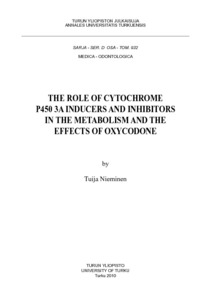The Role of Cytochrome P450 3A Inducers and Inhibitors in the Metabolism and the Effects of Oxycodone
Nieminen, Tuija (2010-12-04)
The Role of Cytochrome P450 3A Inducers and Inhibitors in the Metabolism and the Effects of Oxycodone
Nieminen, Tuija
(04.12.2010)
Annales Universitatis Turkuensis D 932 Turun yliopisto
Julkaisun pysyvä osoite on:
https://urn.fi/URN:ISBN:978-951-29-4465-1
https://urn.fi/URN:ISBN:978-951-29-4465-1
Kuvaus
Siirretty Doriasta
ei tietoa saavutettavuudesta
ei tietoa saavutettavuudesta
Tiivistelmä
Oxycodone is an opioid used in the treatment of moderate or severe pain. It is principally metabolized in the liver by cytochrome P450 3A (CYP3A) enzymes whereas approximately 10% is metabolized by CYP2D6. Little is known about the interactions between oxycodone and other drugs, herbals and nutritional substances. In this work the effects of CYP3A inducers rifampicin and St. John’s wort and CYP3A inhibitors voriconazole, grapefruit juice, ritonavir and lopinavir/ritonavir were investigated on the pharmacokinetics and pharmacodynamics of oxycodone.
All studies were randomized, balanced, placebo-controlled crossover clinical studies in healthy volunteers. The plasma concentrations of oxycodone and its metabolites were determined for 48 hours and pharmacodynamic parameters were recorded for 12 hours in each study. Pharmacokinetic parameters were calculated by noncompartmental methods.
Rifampicin decreased the plasma concentrations, analgesic effects, and oral bioavailability of oral oxycodone. St. John’s wort reduced the concentrations of oxycodone and diminished the self-reported drug effect. Voriconazole increased the exposure to oral oxycodone by 3.6-fold whereas grapefruit juice, which inhibits predominantly the intestinal CYP3A, elevated the mean concentrations of oxycodone by 1.7-fold. Ritonavir and lopinavir/ritonavir increased the mean AUC of oxycodone by 3.0- and 2.6-fold, respectively, and prolonged its elimination half-life. In spite of increased oxycodone plasma concentrations during concomitant administration of CYP3A inhibitors, the analgesic effects were not increased.
These studies show that the induction or inhibition of CYP3A alters the pharmacokinetics and pharmacologic effects of oxycodone. The exposure to oxycodone decreased after induction and increased after inhibition of CYP3A. As a conclusion, the clinicians should avoid concomitant administration of CYP3A inducers or inhibitors and oral oxycodone. If this is not possible, they should be prepared to interactions leading to impaired analgesia after CYP3A inducers or increased adverse effects after CYP3A inhibitors and oral oxycodone.
All studies were randomized, balanced, placebo-controlled crossover clinical studies in healthy volunteers. The plasma concentrations of oxycodone and its metabolites were determined for 48 hours and pharmacodynamic parameters were recorded for 12 hours in each study. Pharmacokinetic parameters were calculated by noncompartmental methods.
Rifampicin decreased the plasma concentrations, analgesic effects, and oral bioavailability of oral oxycodone. St. John’s wort reduced the concentrations of oxycodone and diminished the self-reported drug effect. Voriconazole increased the exposure to oral oxycodone by 3.6-fold whereas grapefruit juice, which inhibits predominantly the intestinal CYP3A, elevated the mean concentrations of oxycodone by 1.7-fold. Ritonavir and lopinavir/ritonavir increased the mean AUC of oxycodone by 3.0- and 2.6-fold, respectively, and prolonged its elimination half-life. In spite of increased oxycodone plasma concentrations during concomitant administration of CYP3A inhibitors, the analgesic effects were not increased.
These studies show that the induction or inhibition of CYP3A alters the pharmacokinetics and pharmacologic effects of oxycodone. The exposure to oxycodone decreased after induction and increased after inhibition of CYP3A. As a conclusion, the clinicians should avoid concomitant administration of CYP3A inducers or inhibitors and oral oxycodone. If this is not possible, they should be prepared to interactions leading to impaired analgesia after CYP3A inducers or increased adverse effects after CYP3A inhibitors and oral oxycodone.
Kokoelmat
- Väitöskirjat [3071]
